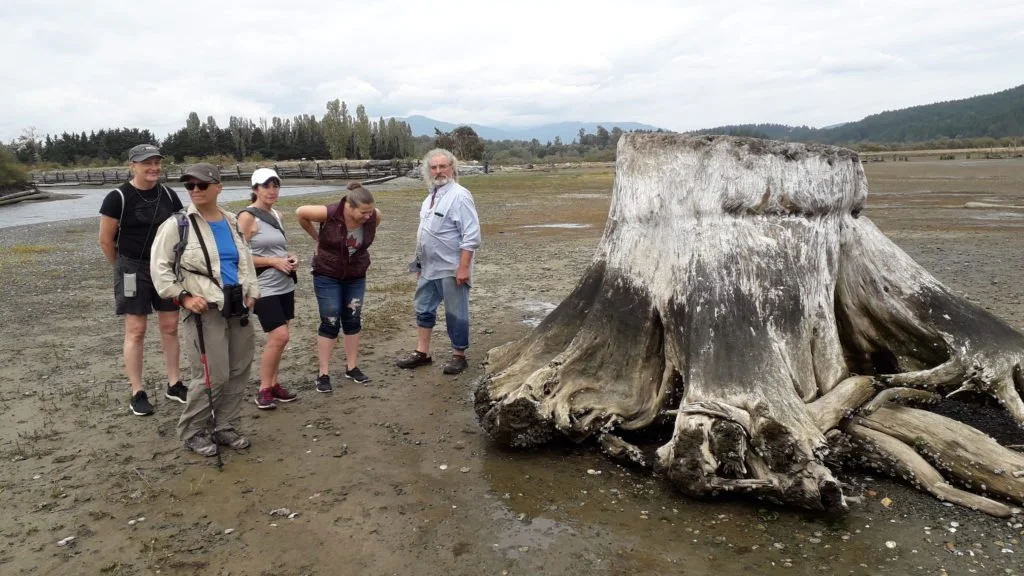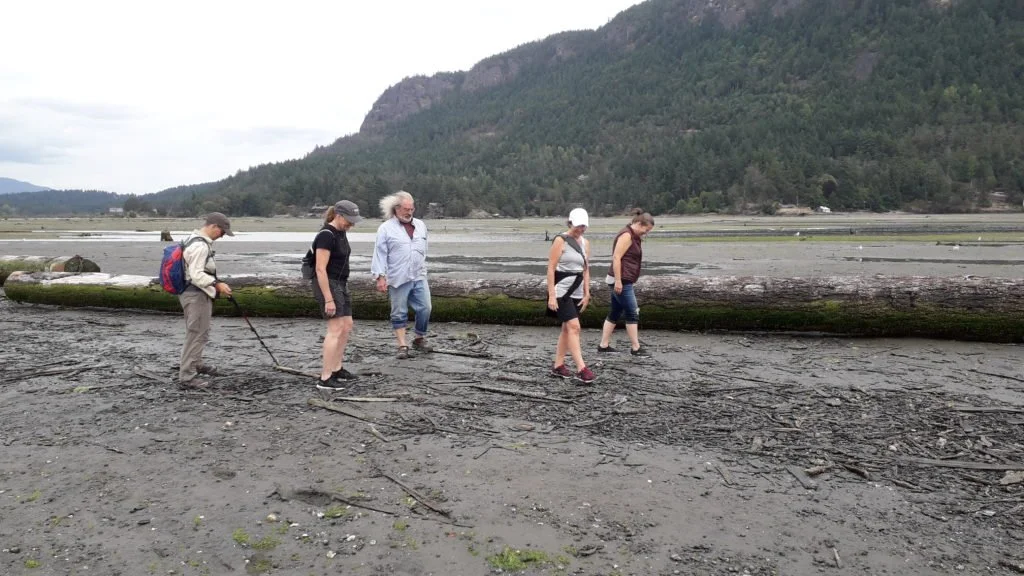Guided Mudflat Walks 2019
Encouraged by the highly positivefeedback from participants of the 2018 guided mudflat walks we offered two moreevents for the 2019 summer season. The walks were open to the public,advertised by the Valley Voice. The first, scheduled for July, had to becancelled due to an unforeseen dredging activity by Western Forest Productsblocking the access to the mudflats from the spit by the mill pond on theplanned date. Since both the dredging and mudflat walk depend on a very lowtide the first walk had therefore to be cancelled on a short notice.Ironically, two days prior to the planned walk mill workers went on strike whichalso prevented the dredging to take place...
The second walk was conducted ata 0.7 tide on August 17. It was a perfect day to get out onto the mudflats.Judging by the feedback of the six participating CERCA members it also was arewarding experience. It makes a difference to just reading about mudflats orexperiencing it first hand in nature. Although the water level of the sidechannel of the Cowichan North Fork at the start of the walk was a bit high tocross, it did not scare away any of our small group.
We discussed and show-cased that tree stumps washed onto the mudflats by the river are not only a characteristic feature of this habitat type but also an important habitat requisite as long as they are firmly anchored in the mud. Such stumps provide food and shelter to many different species and are of special importance at low tide. In contrast loose saw logs as frequently found in the Cowichan estuary, are detrimental to estuarine habitat, especially when washed onto the salt marshes flattening vegetation and destroying seed pods of graminoids such as sedges, a vital food source for over-wintering birds.
Always a special attraction tofirst time visitors of the mudflats are oyster banks. Since oysters afterhatching need a medium to attach to, they are usually found on gravel barswhere they attach to pebbles and rocks. Gravel bars composed of fluvialdeposits are scattered throughout the estuary, a reflection of the dynamics of thissystem where river channels and runnels are constantly changing their course.
Our group displaying very large oysters on thephoto below are standing on the remainder of one of the formerly largest oysterbeds in the estuary which has disappeared very likely as a result of humanactivity. Oysters are called ecosystem engineers for a good reason. Theyprovide habitat to many other species and sequester large amounts of carbonstored in their shells. A mature oyster filters 25 gallons of water every dayin the tidal estuary. Considering the millions of oysters living on the mudflatstheir positive impact on water quality by filtering out toxins, heavy metalsand other impurities is enormous!
Much has been said about theadverse impacts of storage and transport of log booms on the Cowichan estuary.Log booms destined for the local mill of Western Forest Products continue toground out every day at low tide, preventing vital growth of green algae,depositing bark and other woody debris onto the mudflats, and scarring thesensitive bio-film of this important micro-habitat. Green algae which absorbcarbon-dioxide through photosynthesis and storing carbon in the process,contribute more than 50% of the primary production (=vegetation) in theestuary, the key food source at the start of the estuarine food chain. Logbooming and log transport in estuaries along the BC coast and Vancouver Islandis assumed to be partly responsible for the disappearance of eelgrass.
At the time of our guided mudflat tour no log booms were stored in the estuary due to the on-going strike by mill workers, providing a unique opportunity to see first-hand what happens to the substrate beneath the log booms. Large deposits of bark and other woody debris were clearly visible where log booms are usually anchored along the dolphins at the outer edge of the mudflats were once eelgrass fields used to thrive .
Vancouver Island estuaries alongthe east coast where log booming and transport have ceased to exist for yearsfollowed by conservation measures, the results of rehabilitation efforts suchas re-planting eelgrass are promising. It is only hoped that this may also bepossible in the Cowichan Estuary where eelgrass has disappeared completely fromthe northern part of the estuary, currently only found in the southern sectionwhere log booming was stopped more than 40 years ago.
In summary, guided estuary walksprove to be a valuable tool to raise awareness about the ecological functionand importance of estuaries and to learn about the adverse impacts on this highlysensitive ecosystem caused by un-compatible uses and human activity.
Dr. Goetz Schuerholz, Chair CERCA






